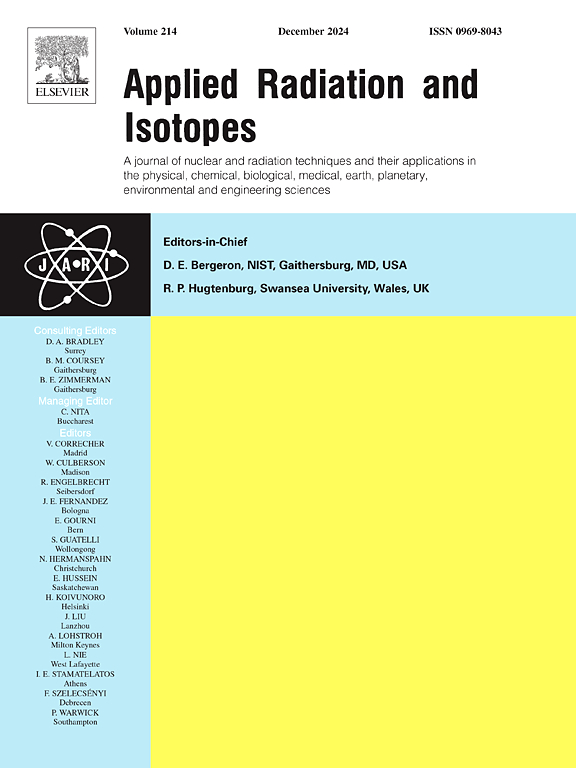印度东南海岸Pazhaverkadu泻湖通过食用鱼类对天然放射性核素进行健康风险评估
IF 1.6
3区 工程技术
Q3 CHEMISTRY, INORGANIC & NUCLEAR
引用次数: 0
摘要
放射性核素可以在水生生物体内生物积累,尽管在周围的水中只有微量。由于其作为南印度捕鱼目的地的重要性,目前的研究正在Pazhaverkadu泻湖进行。20种不同食用鱼类的平均鱼骨总α和β活性分别为13.25 Bq/kg和33.10 Bq/kg。鱼肌总α和总β活性平均值分别为21.98和63.56 Bq/kg。利用α和β辐射源,计算出年有效剂量当量(AED)为0.52 mSv/y;该值低于建议限制。放射学风险指标过量终身癌风险(ELCR)和年度性腺剂量当量(AGDE)的平均值分别为0.001 μSv/y和0.22 μSv/y。研究了20多种鱼类对210Po和210Pb的生物积累。因此,水样中的平均活度分别为1.42 mBq/l和2.44 mBq/l。沉积物样品的平均活度值分别为6.51 Bq/kg和3.16 Bq/kg。鱼肌肉的210Po和210Pb平均活性分别为41.58和2.61 Bq/kg,骨的210Po和210Pb平均活性分别为3.005和4.51 Bq/kg。本研究中210Po和210Pb样品的承诺有效剂量当量(CEDE)值分别为0.04 ~ 0.22 mSv/y、0.003 ~ 0.027 mSv/y和8.82 mSv/y。鱼骨浓度比为2.9 × 103 ~ 6.5 × 103,肌肉浓度比为1.9 × 104 ~ 5.2 × 104;同样,对于210Pb,范围为1.5 × 103 ~ 4.0 × 103和1.6 × 103 ~ 3.5 × 103。调查结果表明,这些数值低于全球平均水平,而且没有对帕扎韦尔卡杜泻湖鱼类消费者的辐射风险进行评估。本文章由计算机程序翻译,如有差异,请以英文原文为准。
Health risk assessment of natural radionuclides through the consumption of fish species in Pazhaverkadu Lagoon, Southeast Coast of India
Radionuclides can bioaccumulate in the bodies of aquatic creatures, albeit to trace amounts in the surrounding water. Due of its importance as a fishing destination in South India, the current study is being conducted in the Pazhaverkadu lagoon. For 20 distinct edible fish species, the average fish bone gross alpha and beta activity were 13.25 Bq/kg and 33.10 Bq/kg. The mean values of gross alpha and gross beta activity of fish muscle were 21.98 and 63.56 Bq/kg respectively. Using the alpha and beta emitters, the Annual Effective Dose Equivalent (AED) of 0.52 mSv/y was calculated; this value is below the recommended limit. The mean values of the radiological risk metrics Excessive lifetime cancer risk (ELCR) and Annual Gonadal Dose Equivalent (AGDE) are 0.001 μSv/y and 0.22 μSv/y, respectively. The bioaccumulation of 210Po and 210Pb for more than 20 fish species was investigated. The mean activity in water samples is therefore 1.42 mBq/l and 2.44 mBq/l, respectively. In contrast, sediment samples have average activity values of 6.51 Bq/kg and 3.16 Bq/kg, respectively. Fish muscle had mean 210Po and 210Pb activities of 41.58 and 2.61 Bq/kg, respectively, whereas bone had mean activities of 3.005 and 4.51 Bq/kg. The committed effective dose equivalent (CEDE) values for the 210Po and 210Pb samples in this study varied from 0.04 to 0.22 mSv/y and 0.003–0.027 mSv/y and 8.82 mSv/y, respectively. Fish bones had a concentration ratio of 2.9 × 103 to 6.5 × 103 and muscles 1.9 × 104 to 5.2 × 104; similarly, for 210Pb, the range was 1.5 × 103 to 4.0 × 103 and 1.6 × 103 to 3.5 × 103. The results of this investigation show that the values are below the global average and that there is no assessment of the radiological risk to the fish consumers in the Pazhaverkadu lagoon.
求助全文
通过发布文献求助,成功后即可免费获取论文全文。
去求助
来源期刊

Applied Radiation and Isotopes
工程技术-核科学技术
CiteScore
3.00
自引率
12.50%
发文量
406
审稿时长
13.5 months
期刊介绍:
Applied Radiation and Isotopes provides a high quality medium for the publication of substantial, original and scientific and technological papers on the development and peaceful application of nuclear, radiation and radionuclide techniques in chemistry, physics, biochemistry, biology, medicine, security, engineering and in the earth, planetary and environmental sciences, all including dosimetry. Nuclear techniques are defined in the broadest sense and both experimental and theoretical papers are welcome. They include the development and use of α- and β-particles, X-rays and γ-rays, neutrons and other nuclear particles and radiations from all sources, including radionuclides, synchrotron sources, cyclotrons and reactors and from the natural environment.
The journal aims to publish papers with significance to an international audience, containing substantial novelty and scientific impact. The Editors reserve the rights to reject, with or without external review, papers that do not meet these criteria.
Papers dealing with radiation processing, i.e., where radiation is used to bring about a biological, chemical or physical change in a material, should be directed to our sister journal Radiation Physics and Chemistry.
 求助内容:
求助内容: 应助结果提醒方式:
应助结果提醒方式:


